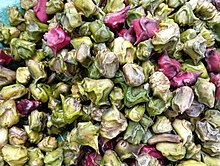**Botanical Characteristics:**
– Water caltrop has a submerged stem reaching 3.7 to 4.6 meters in length.
– It has two types of leaves: finely divided submerged leaves and undivided floating leaves.
– The floating leaves have saw-tooth edges and are ovoid or triangular in shape.
– White flowers form in early summer and are insect-pollinated.
– The fruit is a nut with four barbed spines, with seeds remaining viable up to 12 years.
– Bicornin is an ellagitannin found in T. bicornis.
**Taxonomy and History:**
– The genus has an extensive fossil record with numerous species.
– Fossilized seeds have been found in Cenozoic strata in Europe, China, and North America.
– The oldest known fossils attributed to the genus are of leaves from Cretaceous Alaska.
– The genus became extinct in North America before the Pleistocene.
– Water caltrop has cultural significance in different regions.
– Water caltrop was an important food for worship since the Chinese Zhou Dynasty.
– In India and Pakistan, it is known as singhara paniphal and widely cultivated in freshwater lakes.
– Water caltrop was once commonly sold in markets across Europe.
**Role in Fasciolopsiasis Transmission:**
– Fasciolopsiasis is an ailment resulting from infection by the trematode Fasciolopsis buski.
– The fluke can be transmitted through water plants like water caltrops.
– Larval flukes form cysts on water caltrops, which can infect humans and animals if consumed raw or undercooked.
– Water caltrop plays a role in the transmission of this parasitic infection.
– Proper cooking and hygiene practices are essential to prevent fasciolopsiasis.
**Taxonomic Confusion and Historical References:**
– Water chestnut is often confused with European Trapa and Chinese Eleocharis.
– Common names are not consistently matched to stable botanical names.
– Taxonomic challenges are highlighted in publications by researchers like Berry.
– Historical records provide insights into the water chestnut’s significance.
– Studies reveal the use of water chestnut as a food resource in ancient times.
**Cultural and Culinary Significance:**
– Water chestnut holds cultural importance during Navratra.
– The plant has been utilized in culinary practices for centuries.
– The nutritional value and culinary uses of water chestnut are detailed in resources.
– Culinary traditions involving water chestnut are documented in various historical accounts.
– The plant’s invasive nature and impact on ecosystems are discussed in publications.
**Botanical Research, Conservation, and External Resources:**
– Botanical research institutions provide taxonomic information on Trapa.
– Efforts to manage invasive species like water chestnut are highlighted.
– Conservation initiatives for water chestnut are supported by organizations.
– Research publications contribute to understanding the plant’s ecology.
– External resources like Wikimedia Commons and NatureServe offer information for educational and conservation purposes.
The water caltrop is any of three extant species of the genus Trapa: Trapa natans, Trapa bicornis and the endangered Trapa rossica. It is also known as buffalo nut, bat nut, devil pod, ling nut, mustache nut, singhara nut or water chestnut.
| Water caltrop | |
|---|---|

| |
| Trapa natans | |
| Scientific classification | |
| Kingdom: | Plantae |
| Clade: | Tracheophytes |
| Clade: | Angiosperms |
| Clade: | Eudicots |
| Clade: | Rosids |
| Order: | Myrtales |
| Family: | Lythraceae |
| Subfamily: | Trapoideae Voigt |
| Genus: | Trapa L. |
| Type species | |
| Trapa natans L.
| |
| Species | |

The species are floating annual aquatic plants, growing in slow-moving freshwater up to 5 metres (16 feet) deep, native to warm temperate parts of Eurasia and Africa. They bear ornately shaped fruits, which in the case of T. bicornis resemble the head of a bull or the silhouette of a flying bat. Each fruit contains a single very large, starchy seed. T. natans and T. bicornis have been cultivated in China and the Indian subcontinent for the edible seeds for at least 3,000 years.
